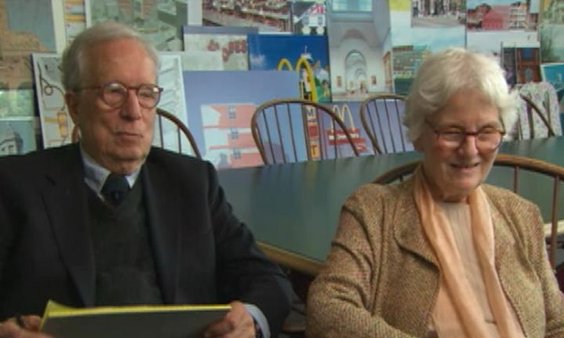NEXT STORY

Learning by doing; how to run studios (Part 2)
RELATED STORIES

NEXT STORY

Learning by doing; how to run studios (Part 2)
RELATED STORIES


|
Views | Duration | |
|---|---|---|---|
| 51. Quotes and the standing of architects in England | 90 | 02:10 | |
| 52. My disillusionment with Louis Kahn | 341 | 03:35 | |
| 53. Princeton and architects that I like | 1 | 97 | 07:44 |
| 54. More on education | 54 | 05:48 | |
| 55. Places that have had an effect on us | 63 | 06:59 | |
| 56. Designing a chapel and a trip to Ravenna, Italy | 1 | 73 | 02:16 |
| 57. Learning from my mother | 58 | 04:56 | |
| 58. Learning by doing; how to run studios (Part 1) | 64 | 04:00 | |
| 59. Learning by doing; how to run studios (Part 2) | 42 | 02:38 | |
| 60. Research, theory and design | 95 | 00:48 |


[DSB] The school I went to taught on the Dalton system and it meant that you did a lot of work for yourself and you… you were kind of taught how to research. And one of the ways they did it, was learning by doing. So, you had projects and I remember as very small children we made models of Egyptian primitive… Egyptian ancient housing, Greek ancient housing. And our teachers had a little difficulty doing that and we learned that much more, because the teachers were having to work out systems and we with them. They became like a player-coach to us, working together with us, which is again the way my mother had been. And sometimes I’d be ill and miss homework, and my mother and I would struggle through the homework together, and she couldn’t do it very well either and then my father would come home in the evening and we’d manage it together. That joint struggling and coming through, I thought was very important for my learning how to educate myself.
But then what I’m really saying is that the projects at Kingsmead taught me about studio and about how to run studios; in other words the whole theory of learning by doing and how you could take that into architecture school. And then, what I did later was, have a theory about how you can learn design by practise, the same way as you don’t learn to ride a bicycle by reading a book about it, you get on it and you fall off and you get back on and you fall off until eventually, there you are riding. And you just have to do that, and you do that in architecture about designing.
But in planning, they have another form of studio, which is teamwork and people share, and they come together in different phases to share their knowledge. And they think of the knowledge they’re finding as something they must share with others and they in fact themselves become teachers. Well, who is learning the most in a situation of teacher and student? Always the teacher. So, I began to realise, let them be the teacher and they’ll learn as much as I’m learning. So, I evolved a way of running studios out of making things with my mother, out of studio which was projects at Kingsmead through architecture and into the studios we ran for Las Vegas and Levittown which were a mixture of research and design with a preponderance of research. And I think that… that is a way of self-education along with a player-coach and along with a group that could be very interesting for academics.
In fact, when I taught at Berkeley and the people there were saying the problem for the students at Berkeley is they’re being taught how to be little academics but they are activists. And then we began to work out, if they were studying studio maybe they’d be happier people, they’d be making things, they’d be learning by doing, they’d be making recommendations, they’d be heading toward action. And, I think, one of the problems with a lot of academic learning is they don’t realise that indeed they are doing that and they do it unawares, so that economists think of themselves as analysts, they’re synthesists as well as analysts and profoundly so, when they do models and systems, but they still call all of that analysis. Once you do that, you’re not responsible to the whole. You think all you have to do is research the variables you can measure, you don’t think about the ones that you can’t measure, which in real life might influence things more. So, a studio mentality, a designer’s mentality, might be useful in many fields, in many public policy fields, just for that reason it makes people responsible to a whole, whether they feel they can handle it or not, they know they must, then they evolve methods to do it.
Internationally renowned architects Robert Venturi (1925-2018) and Denise Scott Brown (b.1931) have helped transform contemporary design through their innovative architecture and planning. Winners of numerous prestigious awards, their designs have championed multiculturalism, social activism, symbolism, pop culture, history and evolving technologies.
Title: Learning by doing; how to run studios (Part 1)
Listeners: Thomas Hughes
Thomas Hughes is Mellon Professor Emeritus of the History of Science at the University of Pennsylvania and Distinguished Visiting Professor at the Massachusetts Institute of Technology. His most recent books include Human Built World, Rescuing Prometheus and American Genesis. He is a member of the American Philosophical Society, US National Academy of Engineering, Royal Swedish Academy of Engineering Sciences and the American Academy of Arts and Sciences.
Duration: 4 minutes
Date story recorded: 22nd to 23rd September 2006
Date story went live: 27 May 2010